Chamita Formation
The Chamita Formation is a geologic formation in north-central New Mexico. It preserves unique fossils dating back to the Neogene period. The presence of volcanic ash beds in the formation, which can be radiometrically dated, gives the absolute age of the fossils, which is valuable for establishing the geologic time scale of the Neogene.
| Chamita Formation | |
|---|---|
| Stratigraphic range: Neogene, | |
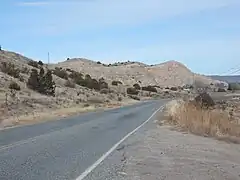 Chamita Formation near the type section, Chamita, New Mexico | |
| Type | Geological formation |
| Unit of | Santa Fe Group |
| Underlies | Puye Formation |
| Overlies | Tesuque Formation |
| Thickness | 210 metres (690 feet) |
| Lithology | |
| Primary | Sandstone |
| Other | Tuff, siltstone, conglomerate |
| Location | |
| Coordinates | 36.0783°N 106.0864°W |
| Region | |
| Country | |
| Type section | |
| Named for | Chamita, New Mexico |
| Named by | Galusha and Blick |
| Year defined | 1971 |
 Chamita Formation (the United States)  Chamita Formation (New Mexico) | |
Description
The formation is mostly coarse quartz sandstone with some coarse gravel. It varies greatly in thickness, likely due to extensive erosion.[1]
There are two prominent tuffaceous zones used by Galusha and Blick for regional correlation. Each is about 30 meters (98 feet) thick and they are separated by 80 meters (260 feet) of tan sediments.[2] Radiometric dating shows that the age of the Upper Chamita Tuffaceous Zone is 6.93 ±0.05 million years at its base and 6.78 ±0.03 million years at its top, essentially identical with the Peralta Tuff, which it also chemically resembles. This helps establish the absolute date for the late Hemphillian, since a fossil assemblage of that stage is found in the zone. The Lower Chamita Tuffaceous Zone has a radiometric age of 7.7 ±0.3 million years.[3] The age range for the complete section has been estimated as 9.5 to 5.8 million years.[4] However, more recent work has yielded an age range of 12 to 13 Ma for a Lower Coarse White Ash Zone towards the base of the formation, which is thickest northeast of the Jemez Mountains and has been interpreted as ash fall from early silicic volcanic activity from vents now buried under later flows.[5]
The base of the formation contains sediments resembling the underlying Ojo Caliente Member of the Tesuque Formation. This is interpreted as reworking of sediments in a changed sedimentation environment rather than interfingering. In other words, the lower part of the formation contains sediments eroded from the Ojo Caliente Member, rather than recording a fluctuating depositional environment.[6]
Members of the formation include the Cejita and Cuarteles Members west of the modern Rio Grande River and the Pilar Mesa, Vallito, and Hernandez Members on both sides of the Rio Grande.[7]
Fossil content
The Round Mountain Quarry has produced numerous fossils from the Chamita Formation. The artiodactyl Osbornoceros osborni was first located in the formation in the Lyden area,[8] as was the only known specimen of the taxideine badger, Chamitataxus.[9]
Color key
|
Notes Uncertain or tentative taxa are in small text; |
Carnivorans
| Carnivorans reported from the Chamita Formation | |||||
|---|---|---|---|---|---|
| Genus | Species | Presence | Material | Notes | Images |
| Aelurodon | A. taxoides | Round Mountain Quarry, Rio Arriba County, New Mexico.[10] | Rami (F:AM 67048, F:AM 67049, F:AM 67052) & a right maxillary fragment (F:AM 107703).[10] | A borophagine dog. | 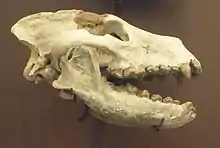 |
| Borophagus | B. secundus | Leyden Quarry, Rio Arriba County, New Mexico.[10] | Left ramus (F:AM 61637).[10] | A borophagine dog. | 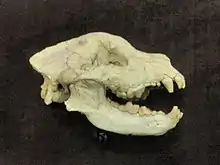 |
| Canis | C. ferox | Leyden Locality, Rio Arriba County, New Mexico.[11] | Left partial ramus (F:AM 27388).[11] | A canine dog. | |
| Carpocyon | C. webbi | Black Mesa, San Ildefonso, Rio Arriba County, New Mexico.[10] | "F:AM 27365, left ramal fragment with m1 broken–m2 and m3 alveolus".[10] | A borophagine dog. |  |
| Chamitataxus | C. avitus | "An almost complete skull with left and right I1-M1".[9] | A badger. | 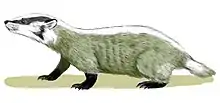 | |
| Epicyon | E. haydeni | Pojoaque Member, Santa Fe County, New Mexico.[10] | Skull, vertebral & limb remains.[10] | A borophagine dog, locality may instead be of the Tesuque Formation. | 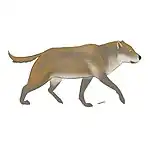 |
| E. saevus | Round Mountain Quarry, Rio Arriba County, New Mexico.[10] | Multiple rami & maxillae.[10] | A borophagine dog. | 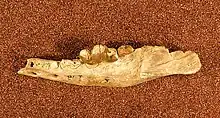 | |
| Eucyon | E. davisi | Rio Arriba County, New Mexico.[11] | Jaw elements.[11] | A canine dog. | 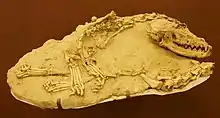 |
| Leptocyon | L. matthewi | Round Mountain Quarry, Rio Arriba County, New Mexico.[11] | Skull remains & metatarsals.[11] | A canine dog also known from the Ash Hollow, Snake Creek & Esmeralda formations. |  |
| Pseudaelurus | P. cf. P. hibbardi | Black Mesa Quarry, Rio Arriba County, New Mexico.[12] | Partial right dentary (NMMNH 45109).[12] | A puma-sized felid. | |
| Vulpes | V. stenognathus | Rio Arriba County, New Mexico.[11] | Several rami.[11] | A fox. |  |
Lagomorphs
| Lagomorphs reported from the Chamita Formation | |||||
|---|---|---|---|---|---|
| Genus | Species | Presence | Material | Notes | Images |
| Hypolagus | H. gidleyi | Mandible (AMNH(FAM) 116845).[13] | A leporid, specimen formerly assigned to H. vetus. | ||
| H. cf. H. gidleyi | Black Mesa Quarry, Rio Arriba County, New Mexico.[12] | Left upper cheek tooth (NMMNH 45110).[12] | A leporid. | ||
| H. cf. H. ringoldensis | Albuquerque, New Mexico.[13] | A mandible (BUNM A7960).[13] | A leporid, specimen possibly from this formation. | ||
| Leporidae | Genus & species indeterminate | Black Mesa Quarry, Rio Arriba County, New Mexico.[12] | Teeth & limb elements.[12] | Leporid remains undiagnostic below family level. | |
Proboscideans
| Proboscideans reported from the Chamita Formation | |||||
|---|---|---|---|---|---|
| Genus | Species | Presence | Material | Notes | Images |
| Gomphotherium | G. riograndensis | Battleship Mountain on the San Ildefonso Pueblo, New Mexico.[14] | A lower jaw (F:AM 21140).[14] | A gomphothere. | |
| Tatabelodon | T. riograndensis | Battleship Mountain on the San Ildefonso Pueblo, New Mexico.[14] | A lower jaw (F:AM 21140).[14] | Regarded a synonym of Gomphotherium. | |
Rodents
| Rodents reported from the Chamita Formation | |||||
|---|---|---|---|---|---|
| Genus | Species | Presence | Material | Notes | Images |
| Muridae | Genus & species indeterminate | Black Mesa Quarry, Rio Arriba County, New Mexico.[12] | Left dentary (NMMNH 45125).[12] | A tiny murid mandible. | |
Ungulates
| Ungulates reported from the Chamita Formation | |||||
|---|---|---|---|---|---|
| Genus | Species | Presence | Material | Notes | Images |
| Antilocapridae | Genus & species indeterminate | Black Mesa Quarry, Rio Arriba County, New Mexico.[12] | Partial lower cheek tooth (NMMNH 45103), distal metapodial fragment ( NMMNH 45104), humeral head (NMMNH 45116) & entocuneiform (NMMNH 45117).[12] | A medium-sized antilocaprid, cannot be identified to any genus or species as taxonomy of the family is based on horn cores.[12] | |
| Dinohippus | D. interpolatus | Black Mesa Quarry, Rio Arriba County, New Mexico.[12] | Teeth & metatarsals.[12] | An equid & the most common species from the Black Mesa Quarry.[12] |  |
| Floridameryx | F. klausi | Round Mountain Quarry, Santa Fe County, New Mexico.[15] | 14 rami & 2 mandibles.[15] | A gelocid. | |
| Hemiauchenia | H. cf. H. vera | Black Mesa Quarry, Rio Arriba County, New Mexico.[12] | Two possibly associated carpal elements (NMMNH 45101, right pisiform; NMMNH 45102, right lunar).[12] | A camelid. | |
| Megatylopus | M. cf. M. matthewi | Black Mesa Quarry, Rio Arriba County, New Mexico.[12] | Dentary fragment (NMMNH 45105), 3 associated fragments of an upper molar ( NMMNH 45106), a partial distal humerus (NMMNH 45129) & 5 vertebrae.[12] | A camelid. | |
History of investigation
The beds making up the unit were originally included by Bryan and McCann in 1937 in the Middle Red member of the Santa Fe Formation.[16] This became the Tesuque Formation in 1956.[17]
In 1971, Galusha and Blick split the uppermost beds from the Tesuque Formation as the Chamita Formation based on differences in lithology and fossil assemblage.[6]
Footnotes
- Galusha & Blick 1971, p. 74.
- Galusha & Blick 1971, p. 71.
- McIntosh & Quade 1995.
- Koning & Aby 2005, p. 261.
- Koning et al. 2013.
- Galusha & Blick 1971, p. 7.
- Koning & Aby 2005.
- Galusha & Blick 1971, p. 76.
- Owen, Pamela R. (August 2006). "Description of a new Late Miocene American Badger (Taxidiinae) utilizing high-resolution x-ray computed tomography". Palaeontology. 49 (5): 999–1011. doi:10.1111/j.1475-4983.2006.00590.x. S2CID 128919144.
- Wang, Xiaoming; Tedford, Richard H.; Taylor, Beryl E. (1999). "Phylogenetic systematics of the Borophaginae (Carnivora, Canidae). Bulletin of the AMNH ; no. 243". hdl:2246/1588.
{{cite journal}}: Cite journal requires|journal=(help) - Tedford, Richard H.; Wang, Xiaoming; Taylor, Beryl E. (2009). Phylogenetic systematics of the North American fossil Caninae (Carnivora, Canidae). (Bulletin of the American Museum of Natural History, no. 325). [New York] : American Museum of Natural History. hdl:2246/5999.
- Morgan, Gary S.; Koning, Daniel J.; Lucas, Spencer G. (January 2005). "Late Hemphillian (Late Miocene) vertebrate fauna from the Black Mesa Quarry, Chamita Formation, Rio Arriba County, New Mexico". Geology of the Chama Basin. New Mexico Geological Society: 408–415. doi:10.56577/ffc-56.408. ISBN 9781585460915. S2CID 130327888.
- White, John A. (1988). "The Archaeolaginae (Mammalia, Lagomorpha) of North America, Excluding Archaeolagus and Panolax". Journal of Vertebrate Paleontology. 7 (4): 425–450. doi:10.1080/02724634.1988.10011674. ISSN 0272-4634. JSTOR 4523165.
- Lucas, Spencer G. (January 2018). "Re-evaluation of the proboscidean Tatabelodon from the Miocene of northern New Mexico". New Mexico Museum of Natural History and Science Bulletin. 79: 485–488.
- Webb, S. David (2008). Revision of the extinct pseudoceratinae: (Artiodactyla: Ruminantia: Gelocidae). Florida Museum of Natural History, University of Florida. OCLC 248636605. S2CID 54194704.
- Bryan & McCann 1937.
- Baldwin 1956, pp. 115–116.
References
- Baldwin, Brewster (1956). "The Santa Fe Group of north-central New Mexico" (PDF). New Mexico Geologic Society Field Conference Series. 7: 115–121. Retrieved 13 May 2020.
- Bryan, Kirk; McCann, Franklin T. (November 1937). "The Ceja Del Rio Puerco: A Border Feature of the Basin and Range Province in New Mexico: I. Stratigraphy and Structure". The Journal of Geology. 45 (8): 801–828. Bibcode:1937JG.....45..801B. doi:10.1086/624608. S2CID 128563355.
- Galusha, Ted; Blick, John C. (1971). "Stratigraphy of the Santa Fe Group, New Mexico" (PDF). Bulletin of the American Museum of Natural History. 144 (1). Retrieved 13 May 2020.
- Koning, Daniel J.; Aby, Scott B. (2005). "Proposed members of the Chamita Formation, north-central New Mexico" (PDF). New Mexico Geological Society Field Conference Series. 56: 258–278. Retrieved 14 May 2020.
- Koning, Daniel J.; Grauch, V. J. S.; Connell, Sean D.; Ferguson, John; McIntosh, William; Slate, Janet L.; Wan, Elmira; Baldridge, W. Scott (1 April 2013). "Structure and tectonic evolution of the eastern Española Basin, Rio Grande rift, north-central New Mexico". New Perspectives on Rio Grande Rift Basins: From Tectonics to Groundwater. doi:10.1130/2013.2494(08). ISBN 9780813724942.
- McIntosh, William C.; Quade, Jay (1995). "40Ar/39Ar geochronology of tephra layers in the Santa Fe Group, Espanola Basin, New Mexico" (PDF). New Mexico Geological Society Guidebook. 46: 279–287. Retrieved 10 August 2020.